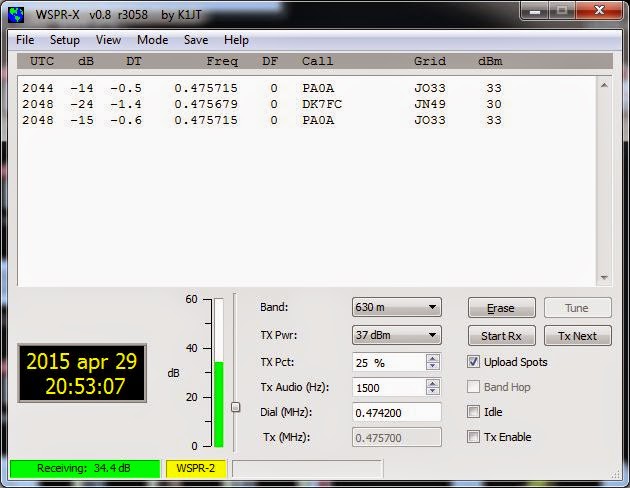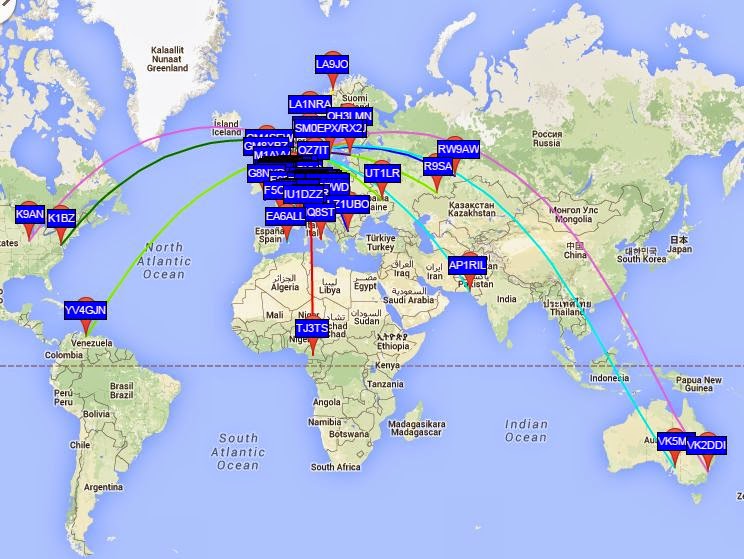Posts Tagged ‘Digital mode’
 First 475 kHz WSPR decoding
First 475 kHz WSPR decoding
Tonight I made the first successful decoding of WSPR on the 630 m band. What inspired me was all the talk on the Elecraft reflector on the new synthesizer which in addition to having less phase noise, also allows the K3 to go below 500 kHz. I don’t have that synthesizer, but the discussion reminded me of the low frequency converter I built many years ago. It converts 0-1 MHz to 14-15 MHz. Using the KXV3 transverter interface of the K3 it was easy to interface and get up and running.
The first signals I decoded are shown in the water fall above, and their origin in Germany and the Netherlands is shown in the next figure.
According to WSPRnet, PA0A’s 2 Watt transmitter is 784 km away from me, and DK7FC’s 1 Watt is 1164 km away.
The converter is based on a 74HC4053 switch used as a mixer with a 74HC04 for a 14 MHz oscillator. It is based on SM6LKM’s design, but with a different oscillator frequency and a simplified output filter. It is one of many small projects that I have built in Altoids tins. The antenna used was my trusty old 80 meter horizontal loop with a 4:1 Elecraft balun.
Perhaps the next step is to finish the 475 kHz filter of my Ultimate 3 WSPR transmitter and see if others can receive me? That is going to be more of a challenge antenna-wise.
 First 475 kHz WSPR decoding
First 475 kHz WSPR decoding
Tonight I made the first successful decoding of WSPR on the 630 m band. What inspired me was all the talk on the Elecraft reflector on the new synthesizer which in addition to having less phase noise, also allows the K3 to go below 500 kHz. I don’t have that synthesizer, but the discussion reminded me of the low frequency converter I built many years ago. It converts 0-1 MHz to 14-15 MHz. Using the KXV3 transverter interface of the K3 it was easy to interface and get up and running.
The first signals I decoded are shown in the water fall above, and their origin in Germany and the Netherlands is shown in the next figure.
According to WSPRnet, PA0A’s 2 Watt transmitter is 784 km away from me, and DK7FC’s 1 Watt is 1164 km away.
The converter is quite simple and is based on a 74HC4053 switch used as a mixer with a 74HC04 for a 14 MHz oscillator. It is the design of SM6LKM, but with a different oscillator frequency and a simplified output filter compared to his. It is one of many small projects that I have built in Altoids tins.
The antenna used was my trusty old 80 meter horizontal loop which has been the main work horse for making my 8-band DXCC (more than 100 countries on all bands 3.5 – 28 MHz) possible. It is fed with ladderline into a 4:1 Elecraft balun in the shack.
Perhaps the next step is to finish the 475 kHz filter of my Ultimate 3 WSPR transmitter and see if others can receive me? That is going to be more of a challenge antenna-wise.
 All continents in one night on WSPR
All continents in one night on WSPR
For me South America, Australia, and Africa are quite rare on WSPR. But they all heard my tiny 0.2 W signal the night between 31 March and 1 April in addition to North America, Asia and Europe. That’s a new one for me and worthy a brag post on the blog, I think! Hopefully, it may also inspire others to try low power WSPR.
In Australia and South America I was heard on the 10 MHz band, in Africa on 21 MHz, in Pakistan on 14 MHz, while 7 and 10 MHz worked into Siberia. North American stations also heard me on the 7 and 10 MHz bands.
This was on my untuned 80 m horizontal loop fed with open-wire feeder and a 4:1 balun. This shows both that the bare-foot Ultimate 3 kit is very tolerant of loads with SWR much different from 1, and that WSPR gives amazing results.
 All continents in one night on WSPR
All continents in one night on WSPR
For me South America, Australia, and Africa are quite rare on WSPR. But they all heard my tiny 0.2 W signal the night between 31 March and 1 April in addition to North America, Asia and Europe. That’s a new one for me and worthy a brag post on the blog, I think! Hopefully, it may also inspire others to try low power WSPR.
In Australia and South America I was heard on the 10 MHz band, in Africa on 21 MHz, in Pakistan on 14 MHz, while 7 and 10 MHz worked into Siberia. North American stations also heard me on the 7 and 10 MHz bands.
This was on my untuned 80 m horizontal loop fed with open-wire feeder and a 4:1 balun. This shows both that the bare-foot Ultimate 3 kit is very tolerant of loads with SWR much different from 1, and that WSPR gives amazing results.
 WSPR on 5 bands
WSPR on 5 bands
For the first time ever I have been spotted on all the five bands that my Ultimate3 QRSS/WSPR kit (G0UPL design) is transmitting on. This is after 2-3 days of transmitting.
Right now I am using the beacon for discovering if the bands should open up on 24 and 28 MHz. The other three bands, and especially the 14 MHz band, serve as references to tell me that the transmitter is working. My antenna is not so optimal so I would be surprised if I am spotted far outside Europe. It is an end-fed 5 m long half wave vertical dipole which isn’t too bad for 28 and 25 MHz, and probably not very good at all on 21, 18, and 14 MHz.
 Ultimate QRSS kits
Ultimate QRSS kits
I’m a great fan of Hans Summers (G0UPL) and his effort in launching kits for various slow speed modes. In fact I have all three generations of the Ultimate QRSS kits up and running. That includes the original single-band kit (30 m in my case, bottom in picture), as well as number 2 and 3, the multi-band kits.
The latest version, in the middle of the picture, has a nicer two line display, and it can also be fitted with a relay board. It makes it possible to jump between up to 6 different bands.
I have used them exclusively in the WSPR mode so far. For time synchronization with the first and last version I have used an EM-406 GPS module which also provides the required pulse-per-second output. My Ultimate 2 has a too early software revision to work with the GPS, so it is on my list for a firmware upgrade.
I have a lot more experimentation to do before I know these kits and their capabilities, but I have at least gotten some experience with how far 150 mW of WSPR can take you, and that was to Australia on 30 m in my case. This is really amazing.
I would recommend the latest kit to anyone who is interested in experimentation with digital modes and who wants to compare e.g. antennas or just observe how propagation varies. The price is reasonable also, starting at GBP £17.50.
The challenge for me has been to find suitable enclosures for the two last kits. I hope to be able to make something from plexiglass for the last one. But I am still looking for that great idea for how to do that.
The last 24 hours on 10 m with a horizontal loop antenna, 80 m long, has caused my tiny signal to be decoded in the US several times as shown below.
See also “My first 24 hours on WSPR” and the G0UPL pages.
 Elecraft K3 modifications
Elecraft K3 modifications
There aren’t that many modifications that you can do to the Elecraft K3. This is very different from the K2 as in my list I now have 138 different modifications for it. But Elecraft does have a few K3 enhancements and mods on their home page and here are two additional modifications that I have done to my K3.
 |
| Plug-in roofing filters on main RX board |
The first one is to add a wideband LC-filter (roofing filter). The filter was inspired by ideas from W5DHM with three tuned sections at the IF frequency of 8.215 kHz. It is to the right in the image. It is not the best of filters, and probably compromises performance somewhat, most likely because of its low image rejection 30 kHz away. It has however served me well as a receiver filter for the latest version of K1JT’s software WSJT-X. That software processes a 4 kHz band for both the JT65 and JT9 digital modes, and the LC-filter has demonstrated to me the utility of having a wide roofing filter for reception of those modes. The filter also works well for listening to broadcast AM which was what W5DHM designed it for in the first place.
 |
| Back panel of the K3 |
The second modification allows for a connection to the P3 Panadapter without using the recommended KXV3A Interface. All that is needed for the P3 is simply a minicoax with proper terminations. On the underside of the main PCB it should have a plug that connects to the J66 connector (see page 10 in the KXV3 manual). In the other end it is soldered to a BNC connector on the back of the K3. I put mine in the hole reserved for the REF input, as I don’t have the K3EXREF External Reference Input option. The BNC connector was marked with a label that says “IF out” as seen in the image.
Both of these modifications are temporary, and as a matter of fact the last one was just replaced by a KXV3A after several years of service. I needed the KXV3A for the PR6-10 preamplifier. I also plan some day to replace the wideband LC-filter with either the KFL3A-6K 6 kHz AM/ESSB filter or the KFL3B-FM 13 kHz FM filter.

















